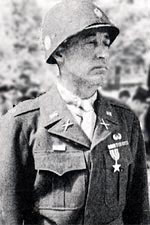|
|
. 321ST GIR . GLIDER FIELD |
|
|
|
. 321ST GIR . GLIDER FIELD |
|
The 321st Field Artillery Battalion was created on August 5th, 1917 and attached to the 82nd Division. The 321st with its two sister regiments (the 319th and 320th) were officially activated as an element of the 157th Field Artillery Brigade on August 29th, 1917 at Camp Gordon, Atlanta and was commanded by Colonel H.C. Williams.
In the beginning the unit was a horse-drawn artillery and the 320th and 321st had each four 7mm guns. The 319th hat 6 15mm guns.
The regiments that composed the 321st were sent to France (Le Havre) on June 3rd, 1918.
The following month, the 321st fought in front of St-Michel and in the Meuse-Argonne area. During the last days of the First World War, the battalion moved from Imecourt to Les Islettes where it camped until the armistice was proclaimed.
The 321st was send back to the United States and was dissolved on Mai 26th, 1919.
It was re-activated on June 5th, 1930 with one extra battery, “C” battery coming from the 452nd. It was created in Georgia and also attached to the 82nd Division.
On the 15th of August 1942, it was re-organised as the 321st Glider Field Artillery Battalion and attached to the 101st under the command of Lieutenant-Colonel Edouad L. Carmichael.
 <-Lieutenant Colonel Edouard L.
Carmichael
<-Lieutenant Colonel Edouard L.
Carmichael
![]() D-DAY – June 44 – Normandy – France – Operation Neptune
D-DAY – June 44 – Normandy – France – Operation Neptune
The 321st Artillery Battalion started the Normandy Campaign when disembarking at Utah beach, but it would take some days before it saw combat.
This was due to the fact that the battalion was divided into two groups on two different boats. The first boat was struck by a mine and had to unload on Omaha beach. There were no losses but they had to wait until June 9th for the unloading of guns and vehicles.
During that time, a part of the battalion served as observatory for the 506th PIR and directed the naval artillery and 105mm self-propelled gun.
June 9th, the 321st supports an assault by the 327th GIR who crosses the Douve River.
They will continue to support the 327th GIR during the first part of the campaign. Once the Douve River is crossed, the 321st is installed near Catz.
It is withdrawn from the front on July 10th, 1944 and returns to England on the 13th July 1944.
On September 19th, 1944 the 321st takes off from Welford in England in gliders and arrives near Eindhoven in the Netherlands.
Its mission is to support the 327th GIR, if attacked by German forces.
It will also provide fire support for the 502nd PIR, enabling the defence of the town of Zon. September 24th, 1944 the 321st is at Uden, together with the 506th PIR, followed at Nijmegen on the 2nd October.
Despite its success, the operation “Market Garden” is a catastrophe near Arnhem. The 321st as well as the 101st Airborne Division leave the Netherlands to return to Mourmelon in France.
![]() Belgium – december 1944 –
Belgium – december 1944 –
In the morning of December 16th, 1944 the Germans launch a major offensive through the Belgian Ardennes Forest, meeting the American defences that are assured by VII Corps.
Their objective is to take the city of Antwerp, thus being the only harbour supporting the allied troops.
At this point, the 101st as well as the 82nd are re-organising in France and kept as reserve.
December 18th, 1944 the 101st is sent to the town of Bastogne, strategic town for the Germans due to a number of major roads that they need for their offensive.
The battalion is part of the forces that will push the German attacks back.
On January 12th, 1945 the 321st supports the 502nd PIR, 506th PIR and the 327th GIR in liberating the village of Foy which is on the road Bastogne-Noville and holds it until the armour belonging to the 4th Division of Patton’s 3rd Army break the encirclement.
January 20th, the 321st is moved to the Alsace Region in France, where the German operation “Whirlwind” is threatening the sector of the 7th Army.
The 321st is moved to Davendorf to support the 506th.
February 23rd, the 321st has returned to Mourmelon in France where the 101st Division receives from General Eisenhower the Distinguished Unit Citation for its bravery in Bastogne.
![]() The End – 1945
The End – 1945
The war in Europe is coming to an end and the 321st is moved to the Ruhr pocket near Nievenheim on the 2nd April.
On April 11th, a contingent of the 321st joins “A” Coy of the 506th PIR for the Rhine crossing and the attack of the town of Himmelgeist.
On May 4th and 5th, “A” Battery of the 321st supports the 506th in its last mission to take the “Eagle Nest” of Hitler at Berchtesgaden.
![]() Awards &
Decorations
Awards &
Decorations
2 Presidential Distinguished
Unit Citations for operations in Normandie and
War Cross with
palms for the
2 War Cross and Lanyard for the Bastogne operations
Lanyard Oranje from the Netherlands for the operation Market Garden